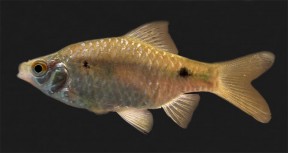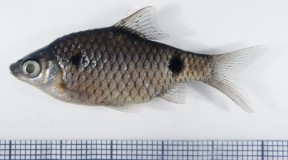Pethia ticto
Ticto Barb
SynonymsTop ↑
Cyprinus ticto Hamilton, 1822; Barbus ticto (Hamilton, 1822); Puntius ticto (Hamilton, 1822)
Etymology
Pethia: the generic vernacular name for small cyprinids in the Sinhala language.
ticto: appears to follow a local vernacular name for the fish.
Classification
Order: Cypriniformes Family: Cyprinidae
Distribution
Type locality is given as ‘southeast parts of Bengal’ by Hamilton, but P. ticto is widely-distributed throughout most of the Indian subcontinent with records from Pakistan, India, Nepal, Bhutan, Bangladesh, and Sri Lanka.
Occurrences in Myanmar and southern China (Yunnan province) may refer to other species but this requires confirmation.
Habitat
Apparently most abundant in shallow streams and minor tributaries, sometimes at relatively high altitudes, and apparently shows a preference for substrates of mud or silt.
Given the extent of its range it would seem sensible to assume that it inhabits various habitat-types which also vary in water depth, flow, and turbidity depending on the time of year.
It occurs alongside numerous other fish species. For example in the Puyankutty River, Kerala state, India sympatric species include Barilius bakeri, B. gatensis, Devario malabaricus, Garra mullya, Dawkinsia arulius, D. filamentosa, Dravidia fasciata, Bhavania australis, Mesonoemacheilus guentheri, M. triangularis, Lepidocephalichthys thermalis, Mystus armatus, M. malabaricus, Aplocheilus lineatus, Pseudosphromenus cupanus, Etroplus maculatus, and Mastacembelus armatus.
Maximum Standard Length
55 – 65 mm.
Aquarium SizeTop ↑
Base dimensions of at least 80 ∗ 30 cm or equivalent are required.
Maintenance
Choice of décor is not especially critical though it tends to show better colouration in a heavily-planted set-up with a dark substrate.
The addition of some floating plants and driftwood roots or branches to diffuse the light entering the tank also seems to be appreciated and adds a more natural feel.
Filtration does not need to be particularly strong though it does seem to appreciate a degree of water movement and will also do well in a hill stream-type set-up.
Water Conditions
Temperature: Has been recorded to tolerate temperatures as low as 58 °F/14 °C but best-maintained between 18 – 25 °C.
pH: 6.0 – 7.5
Hardness: 36 – 215 ppm
Diet
Likely to be a foraging omnivore feeding on worms, insects and other small invertebrates, as well as plant material and organic detritus.
In the aquarium it’s easily-fed but the best condition and colours offer regular meals of small live and frozen foods such as bloodworm, Daphnia, and Artemia, alongside good quality dried flakes and granules, at least some of which should include additional plant or algal content.
Behaviour and CompatibilityTop ↑
Generally very peaceful making it an ideal resident of the well-researched community aquarium.
Fishes inhabiting similar biotopes in nature, especially comparably-sized, open water-dwelling cyprinids perhaps constitute the best choices but other potential options include balitorid, cobitid, and nemacheilid loaches as well as benthic cyprinids such as Crossocheilus and Garra species.
Try to buy a mixed-sex group of at least 8-10 specimens, include other schooling fishes to provide security, and you’ll be rewarded with a more natural-looking spectacle.
The interaction between rival males is interesting to watch and they will display their best colours when competing for female attention or hierarchical position.
Sexual Dimorphism
Adult males are noticeably slimmer and more colourful than females, especially the unpaired and ventral fins.
Reproduction
Like most small cyprinids Pethia spp. are egg-scattering free spawners exhibiting no parental care.
When in good condition they will spawn often and in a mature aquarium it’s possible that small numbers of fry may start to appear without intervention.
However if you want to maximise yield a more controlled approach is required.
The adult group can still be conditioned together but a smaller aquarium should also be set up and filled with mature water.
This should be very dimly lit and the base covered with some kind of mesh of a large enough grade so that the eggs can fall through but small enough so that the adults cannot reach them. The widely available plastic ‘grass’-type matting can also be used and works well, as does a layer of glass marbles.
Alternatively filling much of the tank with a fine-leaved plant such as Taxiphyllum spp. or spawning mops can also return decent results.
The water itself should be of slightly acidic to neutral pH with a temperature towards the upper end of the range suggested above, and an air-powered sponge filter or air stone(s) should also be included to provide oxygenation and water movement.
When the adults are well-conditioned and the females appear gravid one or two pairs should then be introduced, and spawning should take place the following morning.
An alternative is to spawn the fish in a group with half a dozen specimens of each sex being a good number, although a larger aquarium may be necessary.
In either situation the adults will probably eat the eggs given the chance and should be removed as soon as any are noticed.
These should hatch in 24 – 48 hours with the fry free swimming around 24 hours later.
They should be fed on an infusoria-grade food for the first few days until large enough to accept microworm, Artemia nauplii, or suchlike.
NotesTop ↑
This species’ name is frequently misapplied to the congener P. padamya in aquarium literature though in reality the two are easy to tell apart as P. ticto is much the less colourful fish with males lacking reddish-orange pigmentation on the body.
It was formerly included in the Puntius conchonius ‘group’ of closely-related species alongside P. ater, P. bandula, P. conchonius, P. cumingii, P. didi, P. erythromycter, P. gelius, P. khugae, P. macrogramma, P. manipurensis, P. meingangbii, P. nankyweensis, P. nigripinnis, P. nigrofasciatus, P. padamya, P. phutunio, P. punctatus, P. reval, P. shalynius, P. stoliczkanus, P. thelys, and P. tiantian, but all of these were moved to the new genus Pethia by Pethiyagoda et al. (2012), as were P. melanomaculata, P. pookodensis, P. muvattupuzhaensis, P. ornatus, and P. yuensis.
‘Puntius‘ narayani was not moved to the new genus and is currently of uncertain generic placement since it uniquely possesses 9 branched dorsal-fin rays and 6 branched anal-fin rays.
Pethia species are defined by the following combination of characters: rostral barbels absent; maxillary barbels minute or absent; possession of a stiff, serrated last unbranched dorsal-fin ray; presence of a black blotch on the caudal peduncle, and frequently, black blotches, spots or bars on the side of the body; infraorbital 3 deep and partially overlapping the preoperculum.
P. ticto can be told apart from congeners by the following characters: lateral line incomplete with up to 11 pored scales; humeral spot small covering one scale or less transversely and located on lateral line scale 3-4; caudal peduncle marking above posterior of anal-fin on lateral scales 17-19; lateral line with 22 scales or more; 5-5½ scales between lateral line scale row and ventral fins; 8½ branched dorsal-fin rays; dorsal-fin with 1-2 rows of irregular dark spots.
It does however exhibit variations in morphology and colour pattern depending on population, with some having already been described as distinct species and possibly more to follow.
The genus Puntius was viewed as a polyphyletic catch-all containing over 100 species of small to mid-sized cyprinid for a number of years until Pethiyagoda et al. (2012) published a partial review covering South Asian members.
The majority of sub-Himalayan Puntius species were reclassified and new genera Dawkinsia, Dravidia, and Pethia erected to accomodate some of them, with the remainder either retained in Puntius or moved to the existing Systomus assemblage, though the definition of the latter was altered meaning some Southeast Asian species formerly placed there are no longer members.
It subsequently became clear that the name Dravidia was preoccupied by a genus of flesh fly, therefore the replacement name Haludaria was made available by Pethiyagoda (2013).
No species from Indochina, China, or Indonesia were included in the study meaning a significant number of former Puntius are currently classed as incertae sedis, i.e., of uncertain taxonomic placement, and this also applies to a number of South Asian species of unresolved status.
They’re perhaps best referred to as ‘Puntius‘ for the time being whereby the genus name is surrounded by quotation marks to denote its questionable usage, and that is the convention used here on SF at the moment.
References
- Hamilton, F., 1822 - Edinburgh & London: i-vii + 1-405, Pls. 1-39
An account of the fishes found in the river Ganges and its branches. - Ajitkumar, C. R., C. R. Biju, R. Thomas, and P. A. Azeez, 2001 - Zoos' Print Journal 16(4): 467-469
On the Fishes of Puyankutty River, Kerala, India. - Collins, R., K. F. Armstrong, R. Meier, Y. Yi, S. D. J. Brown, R. H. Cruickshank, S, Keeling, C. Johnston, 2012 - PLoS ONE 7(1): e28381
Barcoding and Border Biosecurity: Identifying Cyprinid Fishes in the Aquarium Trade - Knight, J. D. M., K. Rema Devi, T. J. Indra and M. Arunachalam, 2012 - Journal of Threatened Taxa 4(3): 2409-2416
A new species of barb Puntius nigripinnis (Teleostei: Cyprinidae) from southern Western Ghats, India. - Kullander, S. O. and F. Fang, 2005 - Copeia 2005(2): 290-302
Two new species of Puntius from northern Myanmar (Teleostei: Cyprinidae). - Kullander, S. O. and R. Britz, 2008 - Electronic Journal of Ichthyology, Bulletin of the European Ichthyology Society 2: 56-66
Puntius padamya, a new species of cyprinid fish from Myanmar (Teleostei: Cyprinidae). - Linthoingambi, I. and W. Vishwanath, 2007 - Zootaxa 1450: 45-56
Two new fish species of the genus Puntius Hamilton (Cyprinidae) from Manipur, India, with notes on P. ticto (Hamilton) and P. stoliczkanus (Day). - Linthoingambi, I. and W. Vishwanath., 2007 - Zootaxa 1450: 45–56
Two new fish species of the genus Puntius Hamilton (Cyprinidae) from Manipur, India, with notes on P. ticto (Hamilton) and P. stoliczkanus (Day). - Pethiyagoda, R., 2013 - Zootaxa 3646(2): 199
Haludaria, a replacement generic name for Dravidia (Teleostei: Cyprinidae). - Pethiyagoda, R., M. Meegaskumbura, and K. Maduwage, 2012 - Ichthyological Exploration of Freshwaters 23(1): 69-95
A synopsis of the South Asian fishes referred to Puntius (Pisces: Cyprinidae). - Shantakumar, M. and W. Vishwanath, 2006 - Zoos' Print Journal 21(6): 2279-2283
Inter-relationships of Puntius Hamilton-Buchanan (Cyprinidae: Cyprininae) found in Manipur, India.




